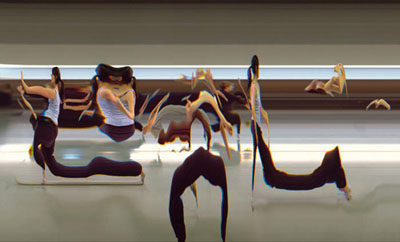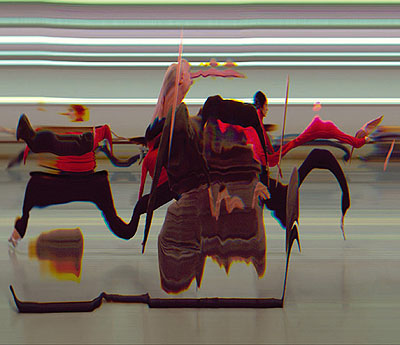
Tai Chi Motion Study
Jay Mark Johnson »
Motion Studies
Exhibition: 4 May – 30 Jun 2007

Galerie Deschler
Auguststr. 61
10117 Berlin
+49 (0)30-2833288
info@deschler-berlin.de
www.deschler-berlin.de
Tue-Sat 12-18

Tai Chi Motion Study #005, 2006
In his series Tai Chi Motion Studies, the American artist Jay Mark Johnson (born 1955) presents photographs of movement. In a process developed by the artist himself, he employs a specially modified camera. While the images retain a spatial dimension in their vertical axis, the horizontal axis is dedicated to a depiction of the passage of time. The camera thus produces an image flowing evenly from left to right. Although the picture is created digitally, it is not digitally manipulated. Rather it is a true indexical recording of a concrete movement. Johnson does not direct the depicted actors, dancers, martial arts performers et al., but allows them to chose movements from within their own disciplines. In the case of the Tai Chi Motion Studies, the form of the depiction is particularly suited to its content, for the practitioners of this graceful physical training maintain that their movements are not caused by isolated muscle impulses, but by the life energy (Qi) flowing through every human body. Physical body, spirit and breath form a profound natural unity. Johnson's photographs become a series of "action paintings" revealing the progressive patterns of the gestures themselves. The hybrid combination of spatial and temporal dimensions creates images that seem both strange and familiar. They not only pique our curiosity but also question our normal mechanisms of perception. Although Johnson's images allude to art historical precursors – above all the chronophotographic studies of movement of the late 19th century (Eadweard Muybridge, Étienne Jules Marey, Albert Londe et al.), as well as the works of Italian Futurism – he goes beyond these in methodology. J.M. Johnson was educated at the Institute for Architecture and Urban Studies and has worked as an assistant to Peter Eisenman, as well as for Rem Koolhaas and Aldo Rossi. Works of his are in the permanent collections of the MOMA in New York, the Smithsonian Institution in Washington, D.C., the Art Institute of Chicago, as well as the Collection Frederick R. Weisman and the Langen Foundation, Hombroich. Johnson's varied and prolific career spans theatre and performance art, photography, live musical performance, and journalism. He co-founded three different alternative television collectives first in Manhattan, and then in Mexico and El Salvador during the eighties at the height of political repression and unrest in those countries. After his return from Latin America he started working in the movie industry and is now a film director with broad experience in visual effects production, having supervised, directed or otherwise contributed to the computer generated imagery for nearly a dozen major studio films and television series, such as Outbreak, Matrix, Titanic, Tank Girl, Moulin Rouge, White Oleander, and music videos for the Red Hot Chili Peppers and others. Jay Mark Johnson lives and works in Los Angeles, USA.
Johnson erteilt den abgebildeten Schauspielern, Tänzern, Kampfsportlern u.a. keine Anweisungen, sondern überlässt es ihnen, Bewegungen aus ihren Disziplinen auszuwählen. Im Fall der Tai Chi Motion Studies spiegelt sich der Inhalt besonders eindrucksvoll in der Darstellungsform wider, denn in dem grazilen Körpertraining kommen die Bewegungen nach Ansicht der Ausübenden nicht durch isolierte Muskelimpulse zustande, sondern durch die Lebensenergie (Qi), die jeden menschlichen Körper durchfließt. Körper, Geist und Atem bilden eine tiefgreifende natürliche Einheit. Johnsons Fotos werden zu einer Serie von "Action paintings", welche die Verlaufformen der Gesten selbst offenlegen. Die hybride Verbindung räumlicher und zeitlicher Dimensionen erzeugt Bilder, die gleichzeitig vertraut wie auch seltsam anmuten. Sie stacheln nicht nur unsere Neugier an, sondern hinterfragen auch unsere normalen Wahrnehmungsmechanismen. Obwohl Johnson auf kunsthistorische Vorläufer Bezug nimmt – vor allem auf die chronofotografischen Bewegungsstudien des späten 19. Jahrhunderts (Eadweard Muybridge, Étienne Jules Marey, Albert Londe u.a.), sowie die Arbeiten des italienischen Futurismus – geht er in seinen Arbeiten methodologisch darüber hinaus. J.M. Johnson hat am Institute for Architecture and Urban Studies studiert und als Assistent von Peter Eisenman sowie für Rem Koolhaas und Aldo Rossi gearbeitet. Arbeiten von ihm befinden sich im MOMA in New York, im Smithsonian Institution in Washington, D.C., im Art Institute of Chicago, sowie in der Sammlung Frederick R. Weisman und in der Langen Foundation, Hombroich. Seine künstlerischen Aktivitäten umfassen Theaterarbeit, musikalische Performances, bis hin zum Journalismus und zur Fotografie. Er ist Mitbegründer alternativer Fernsehgesellschaften in Manhattan und im politisch turbulenten El Salvador der späten 80er Jahre. Nach seiner Rückkehr aus Lateinamerika begann er in der Filmindustrie zu arbeiten und ist mittlerweile Filmregisseur (Mitglied in der Directors' Guild of America) mit großer Erfahrung im Bereich der visuellen Effekte u.a. durch seine Mitarbeit an Filmen wie Outbreak, Matrix, Titanic, Tank Girl, Moulin Rouge, Weißer Oleander und an Musikvideos u.a. für die Red Hot Chili Peppers. Jay Mark Johnson lebt und arbeitet in Los Angeles, USA. Der 1955 geborene amerikanische Künstler Jay Mark Johnson zeigt in seinen Tai Chi Motion Studies fotografierte Bewegungen. In dem von ihm entwickelten Verfahren arbeitet er mit einer speziell modifizierten Fotokamera. Die vertikale Achse der Fotografie bleibt als räumliche Dimension erhalten, während die horizontale Achse die zeitliche Dauer der Bewegung abbildet. Die Kamera erzeugt somit ein gleichmäßig von links nach rechts fließendes Bild. Obwohl die Aufzeichnung digital erfolgt, wird das Foto nicht digital manipuliert. Es handelt sich um die echte indexische Aufnahme einer konkreten Bewegung.

Tai Chi Motion Study #010, 2006

Tai Chi Motion Study #051, 2006